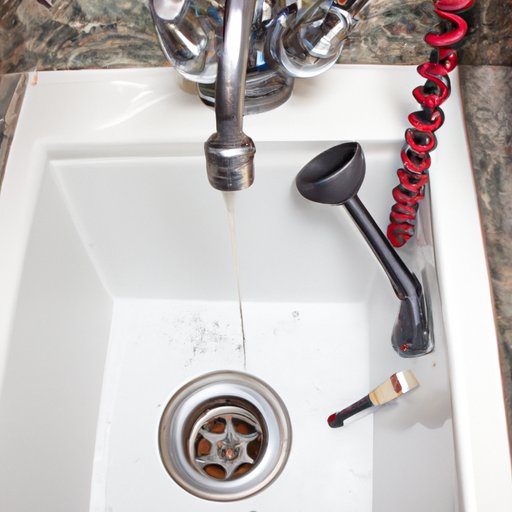Introduction
A clogged kitchen sink drain is an annoyance that most people will have to deal with at some point. A clog happens when food particles, grease, hair, and other debris get caught in the pipes and cause a blockage. The good news is that there are several ways to get rid of the clog and keep your kitchen sink drain running smoothly.
Boiling Water
The first method for cleaning a clogged kitchen sink drain is to use boiling water. Boiling water is an effective way to break up the materials that are causing the blockage. It is also easy to do and requires no special tools or chemicals.
Benefits of Using Boiling Water
- Quick and easy
- No special tools or chemicals needed
- Inexpensive
Step-by-Step Instructions
- Fill a large pot with water and bring it to a boil.
- Carefully pour the boiling water into the kitchen sink drain.
- Let the water sit for a few minutes to allow it to work its way through the clog.
- Run hot water from the tap to flush out any remaining debris.
Baking Soda and Vinegar
Another method for cleaning a clogged kitchen sink drain is to use baking soda and vinegar. This combination creates a natural, fizzy reaction that can help break up clogs. It’s important to note that this method should not be used on metal pipes.
Benefits of Using Baking Soda and Vinegar
- Natural and non-toxic
- Inexpensive
- No special tools needed
Step-by-Step Instructions
- Pour a cup of baking soda down the kitchen sink drain.
- Slowly pour one cup of white vinegar down the drain.
- Cover the drain with a plug or stopper to prevent the mixture from escaping.
- Wait 15 minutes for the fizzy reaction to occur.
- Flush the drain with hot water.
Plunger
A plunger is another tool that can be used to clean a clogged kitchen sink drain. Plungers work by creating suction that can help to dislodge the clog. They are also relatively inexpensive and easy to use.
Benefits of Using a Plunger
- Inexpensive
- Easy to use
- Can be used on any type of drain
Step-by-Step Instructions
- Fill the sink with enough water to cover the plunger cup.
- Place the plunger over the drain and press down firmly to create suction.
- Move the plunger up and down a few times to dislodge the clog.
- Remove the plunger and run hot water down the drain to flush out any remaining debris.
Snake/Auger
A snake or auger is a long, flexible tool that can be used to reach deep into the pipes and remove clogs. This method is more involved than the others, but it can be very effective in removing stubborn clogs.
Benefits of Using a Snake/Auger
- Effective at removing stubborn clogs
- Reaches deep into the pipes
- Can be used on any type of drain
Step-by-Step Instructions
- Insert the auger into the kitchen sink drain until it reaches the clog.
- Turn the crank handle to wind the cable around the clog.
- Continue turning the crank handle until the clog is loosened or removed.
- Pull out the auger and flush the drain with hot water.
Commercial Drain Cleaners
Commercial drain cleaners are chemical-based products that can be used to dissolve clogs. These products are widely available and relatively easy to use, but they can be dangerous if not used properly.
Benefits of Using Commercial Drain Cleaners
- Widely available
- Relatively easy to use
- Can be effective at breaking up clogs
Step-by-Step Instructions
- Read and follow all instructions on the product label.
- Wear rubber gloves and safety glasses when handling the product.
- Pour the product into the kitchen sink drain.
- Follow the instructions on the label for waiting time and flushing the drain.
Enzyme Cleaners
Enzyme cleaners are natural, bacteria-based products that can be used to break up organic materials such as grease, fat, and food particles. These products are relatively safe and can be effective at removing clogs.
Benefits of Using Enzyme Cleaners
- Natural and non-toxic
- Safe for plumbing systems
- Effective at breaking up organic materials
Step-by-Step Instructions
- Read and follow all instructions on the product label.
- Pour the product into the kitchen sink drain.
- Follow the instructions on the label for waiting time and flushing the drain.
Manual Removal of Clogs
In some cases, it may be necessary to manually remove the clog from the pipes. This method requires taking apart the pipes and physically removing the debris. It is best to leave this task to a professional plumber.
Benefits of Manual Removal of Clogs
- Can be effective at removing stubborn clogs
- No need for additional tools or chemicals
Step-by-Step Instructions
- Turn off the water supply to the sink.
- Disassemble the pipes under the sink.
- Locate the clog and remove it.
- Reassemble the pipes and turn on the water supply.
Conclusion
Cleaning a clogged kitchen sink drain doesn’t have to be a daunting task. With the right tools and knowledge, you can easily unclog your kitchen sink drain. Whether you choose to use boiling water, baking soda and vinegar, a plunger, a snake/auger, commercial drain cleaners, enzyme cleaners, or manual removal, you can quickly and easily get your kitchen sink drain flowing freely again.
To prevent future clogs, it’s important to be mindful of what you put down the drain. Avoid pouring grease, oil, coffee grounds, and other debris down the drain. Regularly run hot water down the drain to help keep it clear and reduce the risk of clogs.


